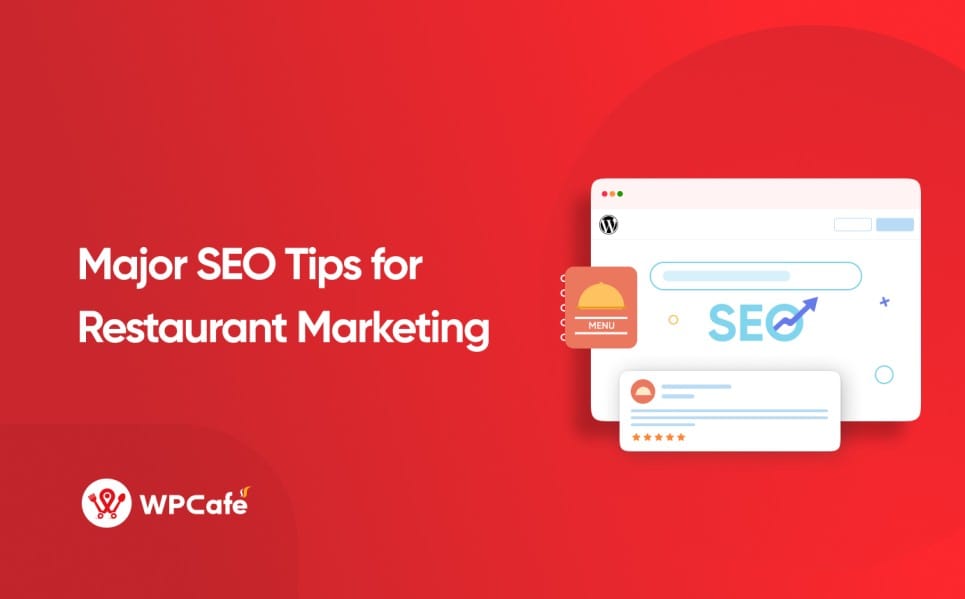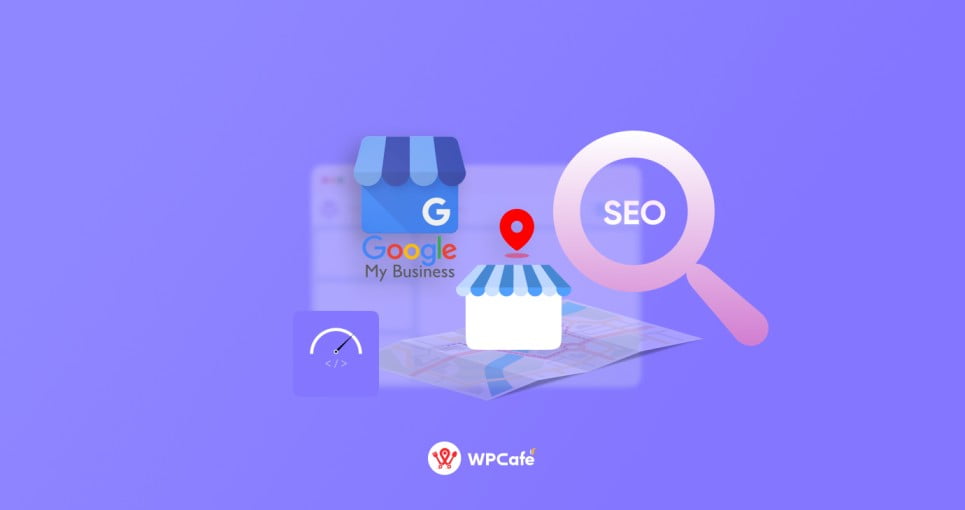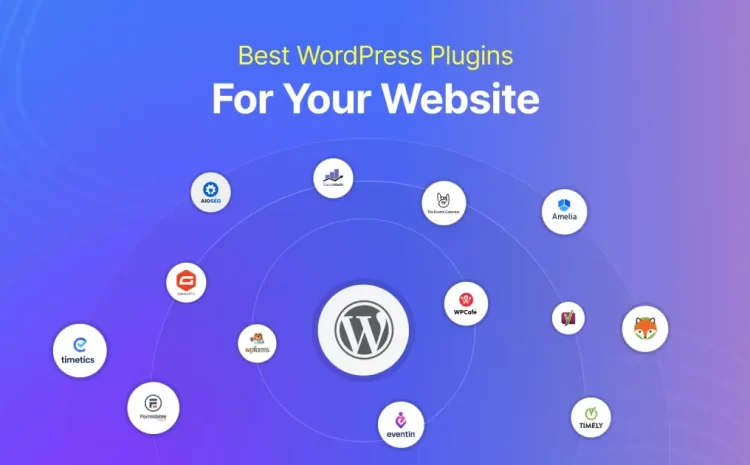Best Restaurant SEO Tips for WordPress: How to Rank Higher and Get More Customers in 2026

Table of Contents
Think of a tourist who checks into your city and types into Google: “best Thai restaurant near me.”
Which restaurant will they choose? Most likely, the one that shows up first — not the one with the best food, but the one with the best SEO. In 2026, search engine results are your restaurant’s front door.
According to BrightLocal’s 2024 survey, 98% of consumers used the online platform to find information about a local business, and 87% checked reviews for restaurants before deciding where to eat.
If your restaurant isn’t optimized for search, you’re losing potential diners to competitors who are just a few keywords ahead. This is where restaurant SEO (Search Engine Optimization) comes in.
The right restaurant SEO strategy helps you:
- Rank higher in search results
- Show up on Google Maps
- Attract local customers for free
In this guide, you’ll learn proven SEO tips for your restaurant website — optimized for WordPress and built to bring more diners through your door.
TL;DR: restaurant SEO checklist for 2026
- Use clear, keyword-rich page titles like “best Italian restaurant in [city]”
- Add your restaurant’s location, cuisine, and service type in headings and content
- Set up and fully optimize your Google Business Profile with menu and booking links
- Add restaurant schema markup to your homepage and menu pages
- Compress and resize all images for mobile speed and Core Web Vitals
- Use an SEO plugin like Rank Math or Yoast to manage meta tags and sitemaps
- Build internal links between menu, about, blog, and reservation pages
- Keep menus and content up to date to improve freshness signals
- Avoid using PDF menus, slow-loading themes, and broken mobile layouts
- Focus on local SEO, AIO (AI optimization), GEO, and AEO to rank in AI and voice search
What is restaurant SEO, and why does it matter in 2026?
Restaurant SEO (Search Engine Optimization) is the process of improving your restaurant’s online visibility so it ranks higher in search results like Google or Bing. That means more people find your restaurant when searching for terms like:
- “best Italian restaurant in NYC”
- “vegan breakfast near me”
- “Thai takeout open now.”
Today, you need to optimize for:
| Aspect | What It Means | Why It Matters for Restaurants |
|---|---|---|
| SEO | Search Engine Optimization | Helps your restaurant rank on Google for searches like “best pizza in Chicago” |
| GEO | Generative Engine Optimization | Ensures AI tools (like Google SGE or ChatGPT) recommend your restaurant in AI-generated answers |
| AIO | AI Optimization | Structures your content so AI assistants can understand your menu, hours, and reviews |
| AEO | Answer Engine Optimization | Helps your site appear in voice search, rich snippets, and zero-click Google answers |
When someone asks:
“What’s the best sushi bar near me open tonight?”
Search engines and AI assistants pull data from well-optimized restaurant sites — using your hours, reviews, photos, and menu schema. If your restaurant isn’t part of that data pool, you’re invisible.
If your restaurant website isn’t optimized for SEO, AIO, GEO, and AEO, you’re missing out on traffic, reservations, and local dominance.
Recommended read
Curious about the future of WordPress and how it affects restaurant websites? Check out our in-depth analysis: is WordPress dying? The state of WordPress in 2026
Core benefits of restaurant SEO (what you actually get)
You’re not investing in SEO just for rankings. You’re investing in discoverability, trust, and consistent growth — all essential to running a profitable restaurant now.
Here’s precisely what effective SEO delivers for restaurants:
1. Rank where customers are searching
When someone searches “Italian food near me” or “vegan cafe open now,” they’re ready to eat — not browse.
A properly optimized restaurant site:
- Shows up in Google’s 3-pack, organic results, and Maps
- Gets pulled into AI-generated answers (via GEO and AIO readiness)
- Appears in voice search and mobile search (via AEO)
This puts your restaurant in front of high-intent local customers at the exact moment they’re looking to decide.
2. Consistent traffic without paid ads
Paid ads stop delivering the moment your budget runs out.
SEO for restaurant websites, on the other hand:
- Brings qualified organic traffic year-round
- Increases visibility for key searches like “best steakhouse in [city]”
- Supports both dine-in reservations and online ordering
The ROI builds over time — no ongoing ad spend required.
3. Better conversion from local pages
Optimized restaurant websites rank — and convert.
That’s because effective SEO:
- Matches keywords to customer intent (e.g., “cheap lunch deals NYC”)
- Surfaces the right pages (menu, hours, booking, reviews) in search
- Makes it easier for visitors to take action: call, book, or order
Well-executed local SEO doesn’t just attract traffic — it turns that traffic into paying customers.
4. Stronger reputation in Google’s eyes
Search engines look at more than keywords. They want signals that your business is real, trusted, and locally relevant. When you invest in restaurant search engine optimization, you build:
- A fully optimized Google Business Profile
- Location-based schema markup (address, hours, menu, cuisine type)
- Reviews, ratings, and local mentions from reputable sources
This not only improves rankings but also builds absolute authority in your local niche.
5. Foundation for AI & voice discovery
Search is changing fast — and AI-generated responses are taking over the top of the SERP.
If your website isn’t optimized for AIO, GEO, and AEO, you’ll be left out of:
- AI Overviews (Google SGE, Bing Copilot, ChatGPT browsing)
- Voice search answers (Alexa, Google Assistant)
- Local queries served through maps and mobile
Doing SEO for a restaurant in 2026 isn’t just about Google — it means you are helping users so they get the right service at the right time.
10 Actionable SEO tips for your restaurant business growth

Most restaurant websites fail at SEO for one of two reasons:
- They’re built for aesthetics, not performance
- They’re missing the fundamentals that drive real search visibility
Here’s how to fix that.
These tips are tailored for WordPress restaurant websites, but they apply broadly to anyone in food service — cafes, delis, fine dining, takeaways, even ghost kitchens.
1. Optimize your homepage and menu page titles
The most important pages on your site are your homepage and menu page — and their title tags should reflect how people search.
For example:
- Wrong: Home | Bella Italia
- Better: Bella Italia | Authentic Italian restaurant in Brooklyn
- Best: Bella Italia – Best Italian restaurant in Brooklyn with online reservations
Your title tag should include:
- Your restaurant name
- Your cuisine or concept
- Your city or neighborhood
- A benefit or keyword-rich phrase
Do the same for meta descriptions. Keep it under 160 characters and write like you’re convincing someone to visit you tonight.
2. Add local keywords to key content areas
If you want to rank for local searches like “best brunch in Dallas” or “Korean BBQ near me,” you need to mention your city and service in the right places.
Add location-based keywords in:
- Homepage headings (H1, H2)
- Paragraph introductions
- Menu descriptions
- Footer business info
- Image alt tags (e.g., “spicy tuna roll – NYC sushi restaurant”)
Don’t keyword-stuff. Just write naturally and use the phrases your customers would actually search.
Pro tip: Use Google’s “People Also Ask” and “Related Searches” to find exact phrases to sprinkle in.
3. Set up and optimize your Google Business profile
This is non-negotiable. If your Google Business Profile is incomplete or outdated, you’re missing out on:
- Google Maps visibility
- Local 3-pack rankings
- AI-generated overviews (GEO and AIO depend on GMB data)
Make sure you:
- Use the correct business category (e.g., “Mexican restaurant”)
- Add high-quality photos of your food and space
- Include menus, hours, and booking links
- Ask satisfied customers for reviews
- Respond to every review (even the negative ones)
4. Use restaurant schema markup to boost visibility
Schema markup helps Google and AI models understand your business better. With the right schema in place, your restaurant can show up with:
- Star ratings
- Opening hours
- Menu highlights
- Price ranges
- Cuisine type
You can implement the restaurant schema using:
- A plugin like Rank Math Pro (includes Local Business and Restaurant schema)
- Manual JSON-LD markup using Schema.org
Here’s a basic example:
{
"@context": "https://schema.org",
"@type": "Restaurant",
"name": "Tandoori Flame",
"address": {
"@type": "PostalAddress",
"streetAddress": "123 Main St",
"addressLocality": "Toronto",
"addressRegion": "ON",
"postalCode": "M5H 2N2"
},
"telephone": "+1-416-123-4567",
"servesCuisine": "Indian",
"priceRange": "$$"
}It makes your site more accessible to both search engines and generative AI models (GEO + AIO benefit).
5. Compress and optimize all images
Restaurant websites are often image-heavy — and that’s a good thing. But uncompressed images will slow your site down, hurt mobile usability, and tank your Core Web Vitals.
To fix it:
- Use WebP format whenever possible
- Compress images using ShortPixel, Smush, or Imagify
- Add descriptive alt text (e.g., “grilled salmon with lemon butter sauce”)
- Use lazy loading to defer off-screen content
6. Choose a fast, mobile-optimized WordPress theme
Most restaurant customers visit your site on their phone while walking, driving, or standing in line. If your site is slow or broken on mobile, you’ll lose them instantly.
Use a lightweight theme like:
- Blocksy
- Astra
- Kadence
- Or a purpose-built restaurant theme with proven performance scores
Test your theme with PageSpeed Insights and prioritize mobile-first performance.
7. Internal linking improves structure and SEO
Think of your website like a restaurant floor plan. It should be easy to navigate, with signs leading to the right rooms.
Do this by:
- Linking your homepage to the most important pages (menu, about, contact, blog)
- Linking from blog posts to relevant dishes or offers
- Adding breadcrumbs and category structure for multi-location or franchise sites
8. Keep content fresh and relevant
Search engines reward active websites. That doesn’t mean you need to blog every week — but it does mean you should:
- Update your hours and offers regularly
- Refresh your menu page when dishes change
- Post timely content (e.g., holiday events, seasonal specials, new chef announcements)
Even small content changes signal freshness to Google and keep your site relevant in AI and voice searches.
9. Focus on reviews and reputation
Google, Bing, Yelp, and TripAdvisor — they all use review signals to determine trust and relevance.
To improve your review signals:
- Set up automated email or SMS review requests after dine-in or delivery
- Link to your review profiles from your website
- Respond to reviews with relevant keywords (e.g., “Thanks for your feedback on our brunch menu in NYC!”)
10. Bonus: Technical SEO tips for your restaurants
You can have great content and design, but if your technical SEO is broken, your rankings will suffer.
Most restaurant websites overlook these basics — which means if you get them right, you instantly gain an edge.
Here’s how to handle the backend of your site so search engines can crawl, index, and rank your restaurant properly.
- Make sure your site has SSL (HTTPS)
If your website still shows up as “Not Secure,” Google is already penalizing you — and users will leave before they even see your menu.
To fix this:
- Get a free SSL certificate via your hosting provider or use Let’s Encrypt
- Make sure your entire site uses HTTPS, not just the homepage
- Use a plugin like Really Simple SSL to auto-redirect old HTTP links
SSL is a confirmed Google ranking factor and a basic trust signal for all restaurant websites.
- Use a mobile-first, responsive design
Google’s indexing is mobile-first — it crawls your mobile version first, not desktop.
Your restaurant website should:
- Load fast on mobile connections
- Use responsive layouts (no horizontal scroll)
- Keep buttons, menus, and contact info thumb-friendly
- Avoid pop-ups that block content on smaller screens
Test your site at Google’s Mobile-Friendly Test and fix any flagged issues.
- Keep your URL structure clean and keyword-friendly
Avoid messy URLs like this:
- https://yourrestaurant.com/page?id=1234
Use clean, descriptive slugs like:
- https://yourrestaurant.com/menu
- https://yourrestaurant.com/about
- https://yourrestaurant.com/best-brunch-nyc
Make sure each URL:
- Uses hyphens, not underscores
- Is short, descriptive, and readable
- Includes keywords where appropriate (e.g., cuisine + location)
Clean URLs are easier for both users and search engines to understand and rank.
- Submit your sitemap to Google
A sitemap helps Google crawl and index all important pages on your site.
To set this up:
- Use your SEO plugin (Yoast, Rank Math, or SEOPress) to generate a sitemap
- Go to Google Search Console and submit your sitemap URL (usually /sitemap_index.xml)
- Check for errors and update it whenever your site structure changes
Without a sitemap, Google may miss pages like your reservation form, gallery, or location-specific offers.
- Set robots.txt and noindex rules for low-value pages
Not every page on your site should be indexed. Pages like:
- Admin login (/wp-admin)
- Cart or checkout pages (if not used for SEO)
- Thank-you pages or PDF menus
Block these with a proper robots.txt file and/or noindex tags:
User-agent: *
Disallow: /wp-admin/
Disallow: /cart/
Disallow: /checkout/Use a plugin like Rank Math to apply noindex to specific pages in WordPress easily.
This keeps Google focused on your most valuable content — like your homepage, menu, and location pages.
- Make your reservation and menu pages crawlable
Many restaurants use third-party booking tools (like OpenTable or external menus) embedded via iframes or links.
What will be the issue? Google can’t crawl or index content in iframes.
To fix this:
- Host your menu and reservation pages on your own domain
- Use structured content and schema on both pages
- Link to them directly from your homepage, header, and footer
It helps your reservation system and menu items appear in local search results — including Google Maps and AI overviews.
Technical SEO isn’t exciting — but it’s the foundation.
If you want your restaurant website to rank consistently in 2026 and beyond, clean up the backend first.
Typical restaurant SEO mistakes to avoid for ensured growth
Most restaurant websites don’t rank because they ignore the basics. These aren’t advanced problems — they’re fixable issues that kill your visibility.
Here are the most common SEO mistakes restaurants make (and how to fix them before it costs you traffic, customers, and revenue).
- Using PDF menus: PDF menus are not mobile-friendly or crawlable by search engines. For instance, create a text-based, on-page menu using a plugin like WPCafe.
- Not optimizing for mobile: If your site is slow or breaks on phones, you’ll lose visitors instantly. You can use a mobile-responsive theme and test performance with Google PageSpeed Insights.
- Ignoring Google Business profile: Without a complete profile, you won’t appear in local search or Maps. So claim your listing, update hours, upload photos, add a booking/menu link, and respond to reviews.
- Missing local keywords: Generic titles like “Welcome to Our Restaurant” don’t help with search. Add city and cuisine-specific phrases (e.g., “best tacos in Dallas”) in your titles, headings, and content.
- Slow-loading images: Large, uncompressed images slow down your site and hurt rankings. Use WebP format, compress with ShortPixel or Smush, and enable lazy loading.
- No internal linking: If pages on your site don’t link to each other, Google may not index them. Link your homepage to the menu, about, blog, and reservation pages. Add breadcrumbs and category links.
- Skipping schema markup: Without structured data, Google can’t show rich results for your hours, menu, or ratings. Add restaurant schema using Rank Math or manual JSON-LD.
- Depending only on ads or social media: Paid ads stop when your budget does. Social posts fade quickly. Invest in long-term visibility with search-optimized content and on-page SEO.
Frequently asked questions regarding the restaurant SEO
-
What is restaurant SEO and why is it important?
Restaurant SEO is the process of optimizing your restaurant website to rank higher in search engines like Google. It helps local customers discover your business when they search for places to eat. A strong SEO strategy increases visibility, website traffic, and table bookings without relying on ads.
-
How do I improve SEO for my restaurant website?
Start by optimizing your homepage and menu titles, adding local keywords, setting up your Google Business Profile, and compressing images for speed. Use WordPress SEO plugins like Rank Math or Yoast to manage meta tags, schema, and sitemaps. Don’t forget to regularly update your menu and add new content to stay relevant.
-
What are the best keywords for restaurant SEO?
The best keywords for restaurants include your cuisine, location, and service. For example:
“best Thai restaurant in NYC”
“family brunch in Chicago”
“vegan cafe open now”
Use long-tail, local, and service-based keywords to target specific customer intent. -
Do I need schema markup for my restaurant website?
Yes. Schema markup helps search engines understand your business details — like menu, hours, pricing, and location. This can improve your chances of showing up in rich results, AI answers, and voice search. You can add restaurant schema using plugins like Rank Math or manually via JSON-LD.
-
How does local SEO help restaurants get more customers?
Local SEO helps your restaurant show up in Google Maps, the local 3-pack, and “near me” search results. It focuses on optimizing your business for location-based searches, customer reviews, local directories, and Google Business Profile data — all of which directly impact real-world foot traffic.
-
Can I do restaurant SEO myself, or do I need an agency?
If you’re using WordPress and have basic technical skills, you can handle most restaurant SEO tasks yourself using tools like Rank Math, WP Cafe, and Google Search Console. However, for competitive areas (like NYC or LA), hiring a local SEO agency may help you scale faster.
Wrap up – are you ready to optimize your restaurant for the search battle?
SEO is no longer optional for restaurant websites — it’s essential. Whether you’re running a cozy café or managing multiple branches, search engines are the first place people look when deciding where to eat.
By focusing on local SEO, technical optimization, and creating a content-rich, mobile-friendly site, you’re not just improving your rankings — you’re driving real bookings, orders, and customer loyalty.
And the best part? You don’t need a massive budget or a complex tech stack to get started.
With WordPress and the right tools, you can handle 90% of restaurant SEO in-house — and WP Cafe makes that process even easier.
Ready to grow your restaurant with better SEO?
WP Cafe helps you create SEO-friendly menus, manage reservations, take online orders, and optimize your entire website — all from one place. Designed for restaurant owners using WordPress, it’s your all-in-one tool to boost visibility and conversions.
Try WP Cafe now
